Your heart is a muscle and like any other muscle in your body, you need to exercise it regularly, so it stays healthy and strong. Physiotherapist Wan Hui Ling from National Heart Centre Singapore (NHCS) shares the best workouts for the heart.
Disclaimer: This article is meant for healthy individuals. If you have any medical condition, please consult your doctor or healthcare professional for medical advice prior to starting an exercise.
Your heart is the most important muscle in your body so shouldn’t you make time to exercise it? Even if you hardly exercise, it’s never too late to start doing it regularly. Just taking a 30-minute brisk walk daily can make a difference.
“For heart health, aerobic exercise and resistance training are important,” shares Physiotherapist Wan Hui Ling from Cardiac Physiotherapy Services at the
National Heart Centre Singapore (NHCS), a member of the
SingHealth group.
Importance of warm ups and cool downs
Warming up and cooling down are also important components of exercise, which are frequently neglected.
Warm up should be done before you exercise to allow your blood vessels to dilate, to ensure that the muscles in your body has sufficient oxygen. It also increases the temperature of your muscles to ensure the ideal flexibility of muscles, which in turn makes them more efficient during exercise. Warm up helps to raise your heart rate slowly, which reduces the stress on the heart. This will also help to reduce the risk of abnormal heartbeats during exercise.
Cooling down after exercising is as important as well. After a workout, your heart rate increases, your body temperature is raised and your blood vessels are dilated. If you stop too quickly, this might cause you to feel faint or unwell. A good cool down routine after an exercise will reduce such episodes and allow for your vitals and body condition to gradually return to normal.
Stretching exercises are recommended during cool down as it can help reduce the lactic acid build-up in the muscles, which can decrease episodes of muscles cramping and stiffness.
Top exercises for your heart
1. Aerobic exercises

Aerobic exercises, also known as cardio, improve your stamina. When doing aerobic exercises, your heart rate will increase and it makes you perspire. They help improve circulation and lower blood pressure. If you have diabetes, they also help to control blood sugar levels.
Examples of aerobic exercises
If you have never or hardly exercise, some easy activities to start with are:
Walking
Biking on flat terrain
Swimming
When you’re ready for a more strenuous workout, you can try:
You can do a mix of moderate and vigorous-intensity exercises during the week to keep your workouts interesting. The key is to do what you love and to do it regularly!
How frequently you need to do cardio exercises
The
American College of Sports Medicine (ACSM) recommends all healthy adults aged 18 to 65 years
should participate in moderate intensity aerobic physical activity for a minimum of 30 minutes on five days per week,
or vigorous intensity aerobic activity for a minimum of 20 minutes on three days per week.
To determine the intensity of your workout, use the Talk Test:
Moderate intensity exercises: You should be able to talk or hold a steady conversation while exercising
Vigorous intensity exercises: You can only say a few words and not conduct a conversation during exercising
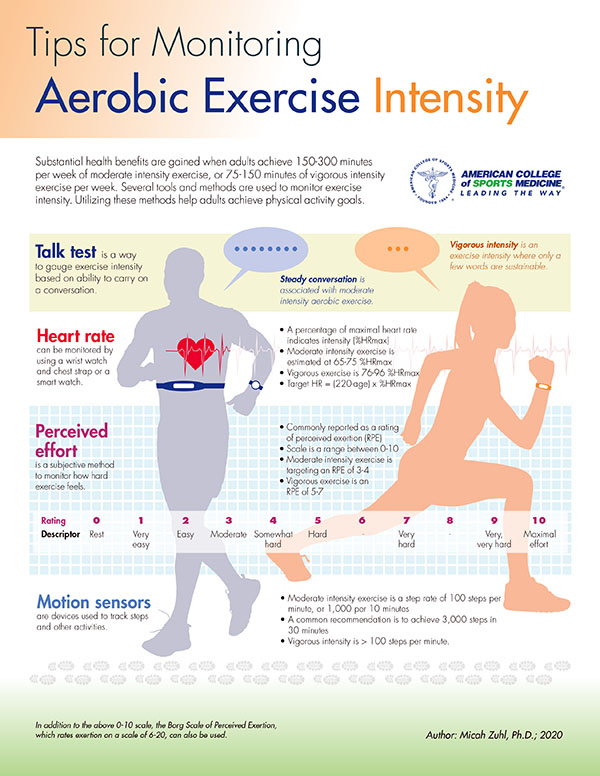
Inforgraphic from the American College of Sports Medicine (ACSM).
2. Strength training (resistance training)

Strength training (also known as resistance training) can help improve body composition. For those with a lot of body fat, it can help reduce fat and create leaner muscle mass. Combining aerobic exercises with strength training can also help raise HDL (high-density lipoprotein), or ‘good’ cholesterol and lower LDL (low-density lipoprotein) or ‘bad’ cholesterol.
Ideally, strength training should work your major muscle groups such as the arms, legs, hips, chest, shoulders, abs and your back.
2 Things to note before you start resistance training
Make sure that you have done your warm up and at least 10 minutes of aerobic exercise before starting resistance training
During resistance training, remember
Examples of strength training (resistance training)
How frequently you need to do strength training exercises
Each strength training exercise should be done in two to three sets of between eight to twelve repetitions. You should start with a weight that you can lift up for at least eight repetitions and progress from there. Having at least two non-consecutive days of strength training per week is ideal.
3. Stretching exercises

Although exercises that promote flexibility such as stretching do not contribute directly to heart health, they reduce your likelihood of getting cramps, joint pain and muscle strain, when engaging in exercises which are essential for a healthy heart.
In seniors, flexibility and balance exercises also help promote stability and prevent falls.
Examples of stretching exercises for major muscles are:
Triceps (muscles at back of arm) | 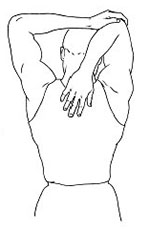 |
Chest muscle (pectoralis major) | 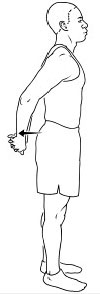 |
Hamstrings (back thigh muscles) |
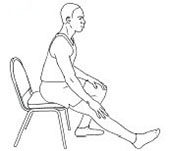
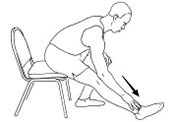
|
Quadriceps (front thigh muscles) | 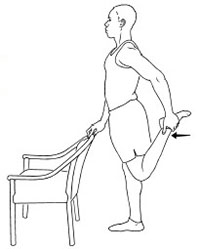 |
Calves (gastrocnemius) | 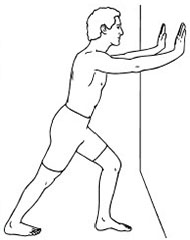 |
Stretching exercises illustrations from Visual Health Information (VHI) Personal Computer (PC)-Kits.
How frequently you need to do stretching exercises
Before and after performing other exercises, in the form of warm-ups and cool-downs. A good warm up and cool down routine should take five to 10 minutes each.
Exercise at home! Follow these simple exercises from National Heart Centre Singapore (NHCS)
Quick 10-minute Beginner Aerobic Exercise (Standing)
Quick 10-minute Beginner Aerobic Exercise (Sitting)
Ref: J22
Check out other articles on exercise and heart health:
Exercises to Lower Blood Pressure
Best Exercises for Seniors
10 Super Foods for Your Heart
5 Tips to Prevent Heart Disease
Cholesterol Food Tips: What to Eat & What to Avoid
